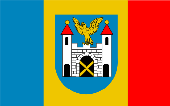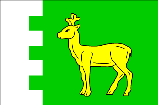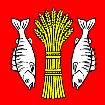The common attitudes and presentation of heraldic beasts are listed below:
- Addorsed
- When two animals are turned back to back – endorsed – but see addorsed 2) in the main text.
- Affronty
- When the head of a beast or a man is shown facing the observer – but see
‘caboshed’ in ‘appendix V’ and
‘affronty 2)’ in the main text (also
‘respectant’ and
‘guardant’ in ‘appendix V’ ).

Bull's Head Affronty, Sable, Vilanova d'Escornalbou, Spain - Armed
- The claws, teeth and beaks of beasts are of a different tincture to the rest
of the body.
![[example of armed beast]](../images/v/vxt-d361.gif)
Lion Rampant Sable, Armed and Langued Gules, Flanders, Belgium - Caboshed
- When an animal's head is borne full-faced and with no part of the neck visible
– cabossed or cabooched – but see
‘affronty’ in ‘appendix V’ (also
‘guardant’ in ‘appendix V’).


A Stag Caboshed, Or, Flag and Arms of Garešnica, Croatia - Contourné
- When an animal is facing towards the sinister rather than the usual dexter – transversed.

Falcon Proper Contourné (Parker)Please note that this term has also been applied (by Scottish heraldic authority) to an inanimate charge turned towards the sinister, but that such use is unsupported by other sources.
- Couchant
- When an animal is depicted as lying down, with its head generally facing towards the dexter.
- Couped
- Cut off in a straight line as is often the case with the heads and limbs of animals but see ‘couped’ main entry (also 'erased').
- Coward
- When an animal is shown with its tail between the hind legs.
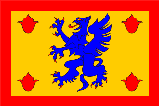
A Griffon Coward, Azure, Armed and Langued gules, Boksburg 1991–94, South Africa - Displayed
- When an eagle or other winged creature is shown with its wings elevated and sometimes inverted (see also ‘rising’ in ‘appendix V’, plus ‘vol’ and ‘volant’ in the main text).
- Erased
- As couped, but with the dividing line ragged or uneven.
- Erect
- When an animal is shown upright or on its hind feet. In certain cases this may be used in place of
"rampant",
or may be employed in relation to the heads of animals and fish – but see
‘erect 2)’ and ‘upright 2)’ in the main text plus
‘haurient’ and
‘rampant’ below.
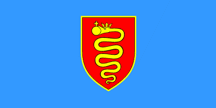

Serpent erect or, Flag and Arms of Gorjani, Croatia (Željko Heimer and fotw) - Forcené
- When a horse is seen rearing on its hind legs – but see also ‘rampant’ and ‘salient’.
- Guardant
- When an animal has its face towards the onlooker – gardant gardant (see also ‘affronty’ and ‘caboshed’ above).
![[example of guardant]](../images/v/vxt-d365.gif)
Three Lions Passant Guardant Or, Armed and Langued Azure, Duchy of Lancaster, UK (Graham Bartram) - Haurient
- The heraldic term when a fish is in the erect position (see also ‘naiant’
and ‘urinant’).


Three Fishes Haurient, Argent, Schwarzenbach, Switzerland; A Dolphin Crowned Haurient Embowed, Démoret, Switzerland - Langued
- The tongue of the beast, if shown, is of different tincture than the rest
of the body.
![[example of langued]](../images/v/vxt-d369.gif)
Lion Passant Sable, Armed and Langued Gules, Aalter, Belgium - Naiant (or natant)
- When a fish (or occasionally a water-fowl) is shown swimming per fess, usually towards the dexter – natant (see also ‘haurient’ and ‘urinant’).
- Passant
- When an animal is depicted walking on all four paws, or with one paw raised, and generally towards the dexter – but see ‘trippant’.
- Proper/Natural
- When a charge is shown in its natural shape and colours, as opposed to stylised heraldic colours or shapes.
- Rampant
- When an animal, particularly (but not exclusively) a lion, is depicted
rearing on its hind legs with forepaws and claws extended – but see
‘forcené’,
‘salient’,
‘segreant’
and ‘erect’.
![[example of rampant]](../images/v/vxt-d373.gif)
Lion Rampant Gules, Armed and Langued Azure, Royal Banner of Scotland (Graham Bartram) - Regardant
- When an animal is looking to the rear over its shoulder irrespective of its attitude.
- Respectant
- When two animals are depicted facing towards each other – combatant, affrontant or affronté (but see note below).

Two Stags Rampant Respectant Argent, Nax, SwitzerlandPlease note, we suggest that a suitable glossary or heraldic dictionary be consulted before using this and the alternative terms given above, however, please note also that the terms affrontant and affronty have different meanings – see ‘affronty’ in ‘appendix V’ and ‘affronty 2)’ in the main text.
- Rising
- When a bird is represented as in the act of taking flight (see also ‘displayed’ in ‘appendix V’, plus ‘vol’ and ‘volant’ in the main text).
- Salient
- When an animal is shown leaping (possibly upon its prey), or rearing up with both hind feet on the ground,
and its forepaws drawn as if level with each other –
but see ‘forcené’, and
‘rampant’.
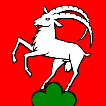
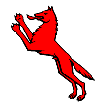
Three Stags salient Argent, Porsanger, Finland; Wolf Salient Gules, Frick, Switzerland - Segreant
- Used in place of rampant when applied to a griffon whose wings are generally expanded – see
‘rampant’ in ‘Appendix V’.
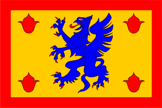
A Griffon Sergeant Azure, Armed and Langued Gules, Flag of Boksburg, South Africa 1981–1994 - Statant
- When an animal is depicted on all four feet standing still whilst facing the dexter.
- Trippant
- When a beast of the chase (a stag, hart, buck etc) is depicted walking on all four hooves,
or with one hoof raised, and generally towards the dexter – but see ‘passant’.
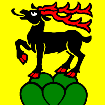

Stag Trippant Sable, Attired and Hoofed Gules, Rebévelier, Switzerland (fotw); Stag Trippant Goules, Rzepin, Poland (Jarig Bakker) - Urinant
- When the head of a fish points downward (see also ‘haurient’ and ‘naiant’).

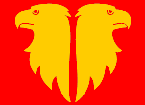
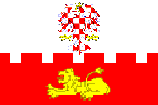
![[example of couped]](../images/v/vxt-d363.gif)
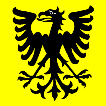
![[example of erased]](../images/v/vxt-d367.gif)
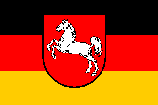

![[example of passant]](../images/v/vxt-d730.gif)


